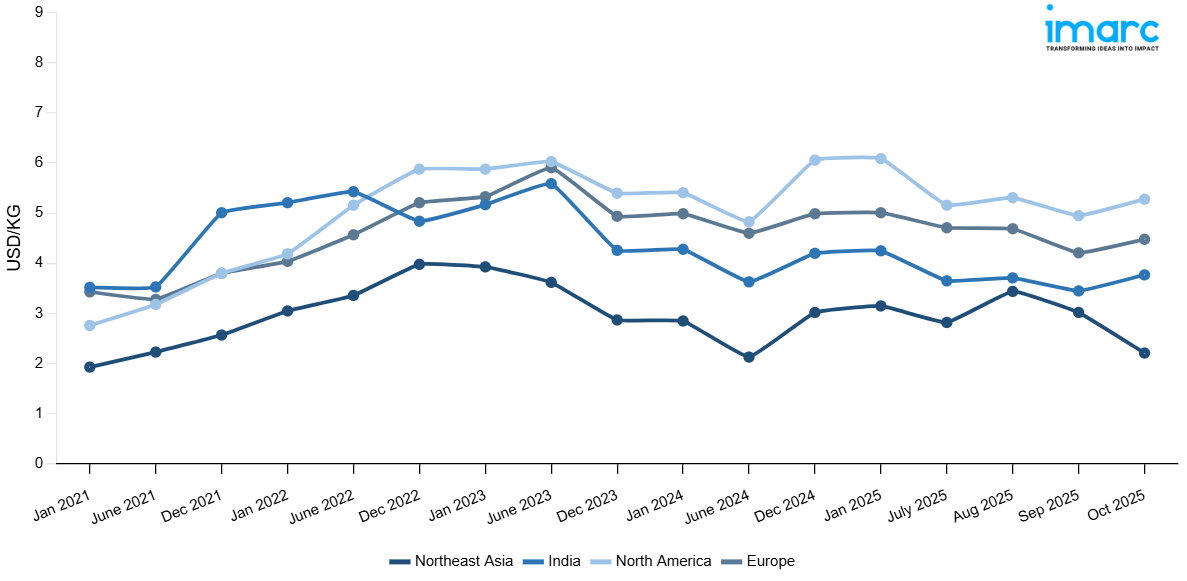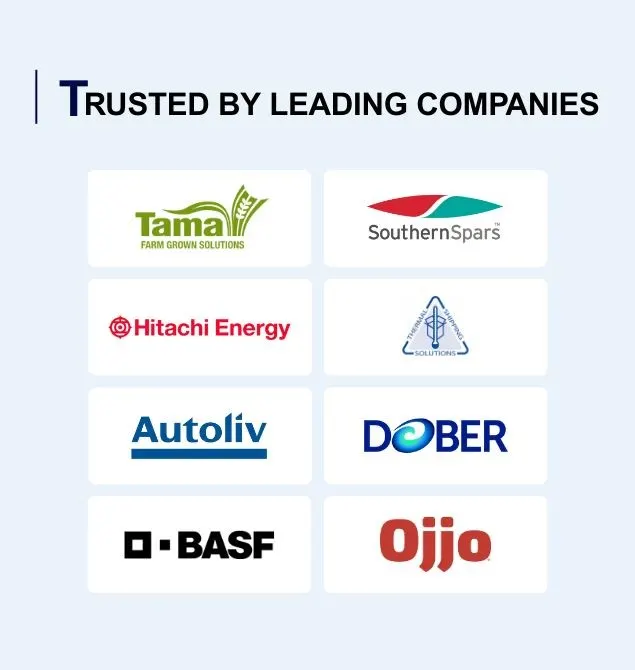
Pyridine Prices, Trend, Chart, Demand, Market Analysis, News, Historical and Forecast Data Report 2025 Edition
Pyridine Price Trend, Index and Forecast
Track real-time and historical pyridine prices across global regions. Updated monthly with market insights, drivers, and forecasts.
Pyridine Prices October 2025
| Region | Price (USD/KG) | Latest Movement |
|---|---|---|
| Northeast Asia | 2.21 | -26.8% ↓ Down |
| Europe | 4.48 | 6.2% ↑ Up |
| India | 3.77 | 9.2% ↑ Up |
| North America | 5.28 | 6.8% ↑ Up |
Pyridine Price Index (USD/KG):
The chart below highlights monthly pyridine prices across different regions.

Get Access to Monthly/Quaterly/Yearly Prices, Request Sample
Market Overview Q3 Ending September 2025
Northeast Asia: Pyridine prices in Northeast Asia experienced a notable decline. This was largely influenced by supply-side factors, including increased production in China and South Korea, which led to an oversupply in the region. Additionally, lower demand from end-use industries, particularly agrochemicals and pharmaceuticals, contributed to the downward pressure. Cost components such as international shipping and port handling saw modest reductions due to improved logistics efficiency, while currency fluctuations, particularly the strengthening of the Chinese Yuan, slightly offset costs for imported raw materials. Compliance costs, including domestic environmental regulations and certification requirements, remained stable, exerting limited influence on the price movement.
Europe: Pyridine prices in Europe decreased. The decline was driven primarily by reduced industrial demand, as several key sectors, including agrochemicals and electronics, scaled back production in response to market saturation. Supply-side factors, such as steady domestic production in Germany, France, and Italy, maintained adequate inventory levels, limiting upward price pressures. Import costs were affected by minor fluctuations in freight charges and customs duties, though currency fluctuations against the USD had only a moderate impact. Additionally, compliance costs related to REACH and other chemical safety regulations remained consistent, ensuring no sudden cost spikes.
India: The price drop reflected a combination of subdued demand from the pharmaceutical and agrochemical industries and a stable supply from domestic manufacturers. International shipping costs and port handling remained largely unchanged, while customs duties on imported raw materials had a minor impact. Currency fluctuations of the Indian Rupee against the USD contributed slightly to pricing adjustments. Logistics and internal distribution costs, including transportation to inland chemical hubs, remained consistent, exerting negligible additional cost pressure.
North America: The reduction was influenced by a combination of steady domestic supply and weakening demand from key end-use sectors such as pharmaceuticals, agrochemicals, and specialty chemicals. International shipping costs and port handling fees were stable, while compliance costs related to environmental and safety regulations remained consistent. Currency fluctuations of the USD had minimal effect on local pricing, and domestic logistics costs, including trucking and warehousing, maintained usual levels. Overall, North American prices saw a moderate decrease, reflecting balanced supply conditions with slightly reduced demand pressures.
Pyridine Price Trend, Market Analysis, and News
IMARC's latest publication, “Pyridine Prices, Trend, Chart, Demand, Market Analysis, News, Historical and Forecast Data Report 2025 Edition,” presents a detailed examination of the pyridine market, providing insights into both global and regional trends that are shaping prices. This report delves into the spot price of pyridine at major ports and analyzes the composition of prices, including FOB and CIF terms. It also presents detailed pyridine prices trend analysis by region, covering North America, Europe, Asia Pacific, Latin America, and Middle East and Africa. The factors affecting pyridine pricing, such as the dynamics of supply and demand, geopolitical influences, and sector-specific developments, are thoroughly explored. This comprehensive report helps stakeholders stay informed with the latest market news, regulatory updates, and technological progress, facilitating informed strategic decision-making and forecasting.
Pyridine Industry Analysis
The global pyridine industry size reached USD 730.94 Million in 2024. By 2033, IMARC Group expects the market to reach USD 1,095.64 Million, at a projected CAGR of 4.37% during 2025-2033. The market is driven by the increasing demand in agrochemicals, expanding pharmaceutical applications, growth in specialty chemicals, and rising use in electronic materials.
Latest developments in the Pyridine Industry:
- March 2025: Lier Chemical Co., Ltd., a Chinese producer of glufosinate, announced its intention to acquire a controlling stake in Shandong Huimeng Biotechnology Co., Ltd. This acquisition aimed to strengthen Lier Chemical's position in the pyridine industry by integrating Shandong Huimeng's expertise in pyridine fluorinated derivatives.
- March 2023: Vertellus Holdings LLC Acquires CENTAURI Technologies and Rebrands as Aurorium. It represents the Company’s growth and evolution as a global materials innovation partner with a diversified portfolio of specialty ingredients and performance-enhancing materials.
- February 2022: A strategic partnership was established between Sino-Agri Leading and Red Sun to expand products supply including diquat and glufosinate. The strategic partnership will give a full play of the business advantage of Sino-Agri Leading as a national-level enterprise in the fields of pesticide distribution and plant protection service.
Product Description
Pyridine is a colorless to pale yellow liquid with a distinct odor, classified as a basic heterocyclic organic compound. It ranks among essential chemical intermediates globally due to its versatility and reactivity. Pyridine is widely used in the production of agrochemicals, pharmaceuticals, and specialty chemicals. Its unique nitrogen atom in the ring structure enables participation in diverse chemical reactions, enhancing product performance. In industrial applications, pyridine serves as a solvent, reagent, and precursor for vitamin B3 synthesis, herbicides, and other fine chemicals, playing a critical role in improving efficiency and stability in formulations across multiple sectors.
Report Coverage
| Key Attributes | Details |
|---|---|
| Product Name | Pyridine |
| Report Features | Exploration of Historical Trends and Market Outlook, Industry Demand, Industry Supply, Gap Analysis, Challenges, Pyridine Price Analysis, and Segment-Wise Assessment. |
| Currency/Units | US$ (Data can also be provided in local currency) or Metric Tons |
| Region/Countries Covered | The current coverage includes analysis at the global and regional levels only. Based on your requirements, we can also customize the report and provide specific information for the following countries: Asia Pacific: China, India, Indonesia, Pakistan, Bangladesh, Japan, Philippines, Vietnam, Thailand, South Korea, Malaysia, Nepal, Taiwan, Sri Lanka, Hongkong, Singapore, Australia, and New Zealand* Europe: Germany, France, United Kingdom, Italy, Spain, Russia, Turkey, Netherlands, Poland, Sweden, Belgium, Austria, Ireland, Switzerland, Norway, Denmark, Romania, Finland, Czech Republic, Portugal and Greece* North America: United States and Canada Latin America: Brazil, Mexico, Argentina, Columbia, Chile, Ecuador, and Peru* Middle East & Africa: Saudi Arabia, UAE, Israel, Iran, South Africa, Nigeria, Oman, Kuwait, Qatar, Iraq, Egypt, Algeria, and Morocco* *The list of countries presented is not exhaustive. Information on additional countries can be provided if required by the client. |
| Information Covered for Key Suppliers |
|
| Customization Scope | The report can be customized as per the requirements of the customer |
| Report Price and Purchase Option |
Plan A: Monthly Updates - Annual Subscription
Plan B: Quarterly Updates - Annual Subscription
Plan C: Biannually Updates - Annual Subscription
|
| Post-Sale Analyst Support | 360-degree analyst support after report delivery |
| Delivery Format | PDF and Excel through email (We can also provide the editable version of the report in PPT/Word format on special request) |
Key Benefits for Stakeholders:
- IMARC’s report presents a detailed analysis of pyridine pricing, covering global and regional trends, spot prices at key ports, and a breakdown of FOB and CIF prices.
- The study examines factors affecting pyridine price trend, including input costs, supply-demand shifts, and geopolitical impacts, offering insights for informed decision-making.
- The competitive landscape review equips stakeholders with crucial insights into the latest market news, regulatory changes, and technological advancements, ensuring a well-rounded, strategic overview for forecasting and planning.
- IMARC offers various subscription options, including monthly, quarterly, and biannual updates, allowing clients to stay informed with the latest market trends, ongoing developments, and comprehensive market insights. The pyridine price charts ensure our clients remain at the forefront of the industry.
Key Questions Answered in This Report
The pyridine prices in October 2025 were 2.21 USD/Kg in Northeast Asia, 4.48 USD/Kg in Europe, 3.77 USD/Kg in India, and 5.28 USD/Kg in North America.
The pyridine pricing data is updated on a monthly basis.
We provide the pricing data primarily in the form of an Excel sheet and a PDF.
Yes, our report includes a forecast for pyridine prices.
The regions covered include North America, Europe, Asia Pacific, Middle East, and Latin America. Countries can be customized based on the request (additional charges may be applicable).
Yes, we provide both FOB and CIF prices in our report.
Need more help?
- Speak to our experienced analysts for insights on the current market scenarios.
- Include additional segments and countries to customize the report as per your requirement.
- Gain an unparalleled competitive advantage in your domain by understanding how to utilize the report and positively impacting your operations and revenue.
- For further assistance, please connect with our analysts.
Why Choose Us
IMARC offers trustworthy, data-centric insights into commodity pricing and evolving market trends, enabling businesses to make well-informed decisions in areas such as procurement, strategic planning, and investments. With in-depth knowledge spanning more than 1000 commodities and a vast global presence in over 150 countries, we provide tailored, actionable intelligence designed to meet the specific needs of diverse industries and markets.
1000
+Commodities
150
+Countries Covered
3000
+Clients
20
+Industry
Robust Methodologies & Extensive Resources
IMARC delivers precise commodity pricing insights using proven methodologies and a wealth of data to support strategic decision-making.
Subscription-Based Databases
Our extensive databases provide detailed commodity pricing, import-export trade statistics, and shipment-level tracking for comprehensive market analysis.
Primary Research-Driven Insights
Through direct supplier surveys and expert interviews, we gather real-time market data to enhance pricing accuracy and trend forecasting.
Extensive Secondary Research
We analyze industry reports, trade publications, and market studies to offer tailored intelligence and actionable commodity market insights.
Trusted by 3000+ industry leaders worldwide to drive data-backed decisions. From global manufacturers to government agencies, our clients rely on us for accurate pricing, deep market intelligence, and forward-looking insights.
 Request Customization
Request Customization
 Inquire Before Buying
Inquire Before Buying
 Speak to an Analyst
Speak to an Analyst Request Brochure
Request Brochure




.webp)




.webp)












